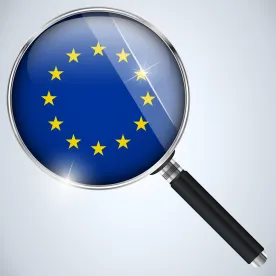Digital Single Market PolicyOn May 25, 2016, the European Commission presented a three part plan to boost e-commerce by tackling geoblocking, making cross-border parcel delivery more affordable and efficient, and promoting customer trust through better protection and enforcement—see the press release here. On geo-blocking, the Commission is proposing legislation to ensure that consumers seeking to buy products and services in another EU country, be it online or in person, are not discriminated against in terms of access to prices, sales or payment conditions, unless this is objectively justified for reasons such as VAT or certain public interest legal provisions. For parcel delivery, the Commission has proposed a new regulation to improve price transparency, return options, and complaints procedures for cross border parcel delivery—see the proposal here. The Commission has stopped short of introducing price caps on delivery prices. Finally, the proposed revision of the Consumer Protection Cooperation Regulation will give more powers to national authorities to check if websites geo-block consumers or offer insufficient after-sales conditions; order the immediate take-down of websites hosting scams; and request information to detect the identity of the trader in question. On May 25, 2016, the Commission proposed an update of the 2010 Audio-Visual Media Directive and announced a new Commission approach to online platforms (see below). In respect of the update of the 2010 Directive, following a public consultation (see here), the Commission has proposed new obligations on video-sharing platforms. Platforms that organize and tag a large quantity of videos will have to protect minors from harmful content (such as pornography and violence) and protect all citizens from incitement to hatred. The Commission will also oblige on-demand providers to ensure they carry at least a 20% share of European content in their catalogues. Member States can request that on-demand services available in their country contribute financially to Europeans works. There will also be changes to the rules on broadcasting time, and greater flexibility to use product placement and sponsorship. The proposals give national audiovisual regulators the power to enforce the rules, breaches of which can lead to fines if the national implementing legislation so requires. A group of all 28 national audiovisual regulators will assess co-regulatory codes of conduct and advise the European Commission. The Commission’s new approach to online platforms will focus on industry and stakeholder efforts for self- and co-regulation—see the Commission Communication here, and a staff working document here. The Commission will seek to ensure there are comparable rules for comparable digital services, and to create an obligation for online platforms to behave responsibly. Specific problems will be addressed through targeted instruments, such as audio-visual or copyright rules; or enhanced voluntary efforts by industry, such as a code of conduct on combatting hate speech online, secure electronic identification (eID) systems; and voluntary efforts to tackle practices such as fake or misleading online reviews. The Commission will conduct additional fact-finding on issues such as transparency and unfair terms and conditions for suppliers on platforms, to determine by spring 2017 whether additional EU action in this area is needed. On May 31, 2016, Facebook, Twitter, YouTube and Microsoft, together with the European Commission, launched a code of conduct that includes a series of commitments to combat the spread of illegal hate speech online in Europe. The four companies commit to continuing their efforts to tackle illegal hate speech online. This will include the continued development of internal procedures and staff training to guarantee that they review the majority of valid notifications for removal of illegal hate speech in less than 24 hours and remove or disable access to such content, if necessary. On June 1, 2016, the Commission announced a package to modernize ICT standardization—see the press release here, the Commission Communication here, and Q&A here. The package includes a Commission Decision providing the framework for the Joint Initiative on Standardisation (JIS). The JIS will be launched on June 13, bringing together European and national standardization organizations and bodies, industry, SMEs, consumer associations, trade unions, environmental organizations, Member States and the Commission. The JIS seeks to prioritize and modernize certain standard setting processes by the end of 2019. It will also promote the use of European standards at international level. The proposal for a 2017 work program for European standardization (also announced, see here) identifies a number of priorities—namely, specific ICT sectors (5G, cloud computing, internet of things, data technologies and cybersecurity) and the services sector generally. On June 2, 2016, the Commission published guidelines on the “collaborative economy”. The Commission offers guidance to Member States on how existing EU law should be applied, clarifying issues such as market access requirements, liability, EU consumer law, employment and tax. Under these guidelines, absolute bans of an activity should only be a measure of last resort, and platforms should not be subject to authorizations or licenses where they only act as intermediaries between consumers and those offering the actual service (e.g., transport or accommodation services). Energy and Climate Change PolicyBy the end of the year, the European Union will have to decide whether the global scheme negotiated within ICAO to limit the carbon dioxide (CO2) emissions of international aviation is ambitious enough to leave the aviation sector outside the scope of the European Emission Trading System (“ETS”). The EU ETS is a “cap and trade” system of emissions rights. Those sectors that are included are required to buy emission rights to cover their CO2 emissions, while the amount of emission rights is gradually reduced every year. Thus the ETS puts a price on the emissions of CO2, and creates a financial incentive for companies to limit them over time. Due to strong international pressure, the inclusion of emissions from airplane flights between airports in the European Economic Area (“EEA”) and those outside the Area (but not intra-EEA flights) is suspended until the end of 2016. This suspension is intended to allow the UN aviation body, ICAO, to reach an agreement on a Global Market-based Measure Scheme to limit CO2 emissions from international aviation. The ICAO General Assembly is expected to review the final agreement on this Scheme for aviation on September 27, 2016. The current draft agreement (see here) intends to cap and offset the increase above 2020 levels in CO2 emissions from international aviation. It includes two elements that may prove problematic for the EU. First, a newly added paragraph states that the global offsetting scheme would be “the exclusive market-based measure applying to CO2 emissions from international aviation, unless agreed otherwise between affected States.” This provision is likely to be interpreted as preventing the inclusion of intra-EEA flights in the EU ETS, unless this is agreed by all affected States. Second, while the EU ETS is intended to reduce aviation emissions, ICAO’s Global Market-Based Measure Scheme would merely impose a cap on aviation emissions as of 2020, and require airline companies to offset any emissions in addition to their 2020 levels. The exclusion of intercontinental flights in the ETS will be lifted automatically by the end of 2016, unless the EU is convinced that the ICAO agreement meets its expectations, and amends the EU ETS Directive through the ordinary legislative procedure. This would require the Commission to present a proposal to the Parliament and Council on the basis of its report on the ICAO agreement. Before the end of this summer, the European Commission is expected to present proposals for scientific criteria to identify endocrine disrupting chemicals, as required by the Plant Protection Products Regulation and the Biocidal Products Regulation. Endocrine disruptors are chemical compounds that interfere with natural hormone systems. The criteria to determine endocrine-disrupting properties were in fact due by December 13, 2013, under the Biocidal Products Regulation. In December 2015, the General Court ruled that the Commission breached EU law by failing to adopt necessary delegated acts with scientific criteria for the determination of endocrine-disrupting properties—see here. The European Parliament has added considerably to the pressure on the Commission to act. In May 2016, a group of MEPs submitted a motion of censure against the Commission over its failure to publish the scientific criteria—see here. The motion of censure failed to assemble the necessary number of signatures in order to be put to a vote in the European Parliament. However, on June 8, the Parliament adopted a resolution condemning the Commission’s delay—see here. To date, the Commission has refrained from publishing criteria to identify endocrine disruptors, due to concerns as to whether such identification should be strictly hazard based, or also take into account the actual risks of the substance in question. Industry favors a more risk-based approach, as it would like to see the inclusion of “potency” as an element of hazard characterization. This would allow products containing endocrine disrupting chemicals to be placed on the market, where they do not meet certain harm thresholds—such thresholds being determined on the basis of a full analysis of the health impacts of those endocrine disrupting chemicals, given certain exposure levels. On the other hand, a strict hazard-based logic, preferred by NGOs, would simplify the management of potential health risks and avoid debates on whether there are any “safe” thresholds. Regardless of the approach that is followed, the definition of criteria to identify endocrine disruptors is likely to increase significantly the number of substances that may be subject to restrictions and additional requirements under the REACH Regulation, the Biocidal Products Regulation, the Plant Protection Products Regulation and other regulatory regimes. Internal Market and Financial Services PolicyIn May, the European Commission presented a legislative proposal to delay by a year the transposition and application dates of the new European securities market rules. In 2014, the European legislators adopted an extensive revision of the rules on financial instruments (Regulation 600/2014 (“MIFIR”) and Directive 2014/65/EU (“MIFID II”)) aimed at improving transparency, investor protection and competitiveness of financial trading services in the EU. On October 2, 2015, the European Securities and Markets Authority (ESMA) informed the Commission that a delay in implementation was unavoidable as essential data infrastructure would not be in place on time. The new deadline for the Member States to transpose MIFID II into national legislation is set for July 3, 2017; the new date of application of both MIFID II and MIFIR is set for January 3, 2018. On May 12, 2016, the European Commission launched six public consultations on EU consumer and marketing legislation as part of a “Fitness Check” to assess whether six Directives are proportionate to their objectives and are delivering as expected. The Directives in question are:
According to the roadmap outlining the review process (see here), key concerns for this review include whether these directives have achieved consumer protection and market integration efficiently, the potential for simplifying the regulatory framework, and whether the directives are still fit for purpose, given changes in markets and consumer behavior. The public consultation closes on September 2, 2016—see here. Life Sciences and Healthcare PolicyOn May 25, 2016, the Dutch Presidency of the Council announced that they and the European Parliament had reached a political agreement on the proposed Regulations on medical devices and on in vitro diagnostic medical devices (IVDs)—see the press release here, and the Commission’s webpage on the proposed revisions here. At this time, the final texts are not yet available. However, according to the press release, the agreement would strengthen the rules on marketing devices and tighten market surveillance. The responsibilities of manufacturers and other economic operators would be clarified, with explicit provisions on the follow-up of the quality, performance and safety of devices placed on the market. In addition, devices will have a unique identification number to provide traceability throughout the supply chain, and a central database will be set up for all relevant information covering economic operators, notified bodies, market surveillance, vigilance, clinical investigations and certificates. There is said to be an outstanding question in respect of the reprocessing of medical devices intended for single use by hospitals, and until the texts are released, it is unclear how this will be resolved. The texts must now be translated into the 24 official languages of the EU, reviewed for consistency by lawyer-linguists, and formally adopted by the European Parliament and the Council. This is not likely to happen before the summer. The Regulations would then be published in the Official Journal, and will come into force three years thereafter for the Medical Devices Regulation, and five years thereafter for the IVDs Regulation—i.e., in late 2019 and 2021, respectively. Trade Policy and SanctionsThe deal between the European Union and Turkey on March 18 was concluded with Prime Minister Ahmet Davutoğlu, with President Recep Tayyip Erdoğan ostensibly keeping his distance from the negotiations. So when Davutoğlu stepped down on May 5 following disagreements with President Erdoğan, many observers concluded that the whole agreement could well collapse. President Erdogan indeed confirmed that he intends to follow a much tougher line. Soon after Davutoğlu’s resignation, he made clear that Turkey would not change its Anti-Terror Law, a condition set by the EU for agreeing on the visa liberalization. Later, in a public statement, he threatened to renounce having the Turkish Parliament ratify the deal on migration if the EU did not fulfill its “obligations” regarding visa liberalization. This apparent deadlock brought even the German newspaper Bild to announce—citing high level German sources—that the EU was considering giving the billions it had promised to Turkey to Greece instead, if the deal agreed with Ankara to stem the refugee flows collapses. However, at the end of May, EU sources continued to insist that the visa deal with Turkey (as well as with Georgia, Ukraine and Kosovo) would be finalized on time, but it becomes ever clearer that the deadline of the end June will be postponed to the fall. Bulgaria and Romania indicated, in April, that they intended to oppose the conclusion of the free trade agreement between the EU and Canada (“CETA”), expressing disappointment that Ottawa had not agreed to lift the visa obligation imposed on them. Canada indeed has a visa-free regime with all EU countries except Romania and Bulgaria, and has not delivered on its promise to resolve the issue, contained in a declaration from the 2014 EU-Canada summit (see here). The problem is even more delicate with the U.S., who maintain a visa requirement not only for the citizens of Bulgaria and Romania, but also of Poland, Croatia and Cyprus. An EU Regulation requires EU countries to “react in common” on visa matters, especially in cases where foreign countries “subject [EU] citizens to differing treatment”, but the Commission decided that the consequences of the EU imposing visas on Canada (not to mention the U.S.) would be so dire that the EU legislation requiring reciprocity could not be applied. Therefore, instead of introducing visas for Canadian nationals travelling to the EU, the Commission decided to send the issue for debate in the Council and the European Parliament. A discussion took place on May 13 at the Foreign Affairs Council, which did not give up on having CETA concluded on the occasion of the EU-Canada Summit in October, hoping that in the meantime—or during the process of ratification—the visa issue for Bulgaria and Romania will be solved. |
EU Policy Update: E-Commerce Boost, Carbon Dioxide Emissions, MIFID II
Wednesday, June 8, 2016
Current Public Notices
Published: 28 August, 2025
Published: 25 August, 2025
Published: 25 August, 2025
Published: 25 August, 2025
Published: 25 August, 2025
Published: 22 August, 2025
Published: 20 August, 2025
Published: 20 August, 2025
Published: 18 August, 2025
Published: 18 August, 2025
Published: 15 August, 2025
Published: 14 August, 2025
Published: 12 August, 2025
Published: 11 August, 2025
Published: 8 August, 2025








 />i
/>i
